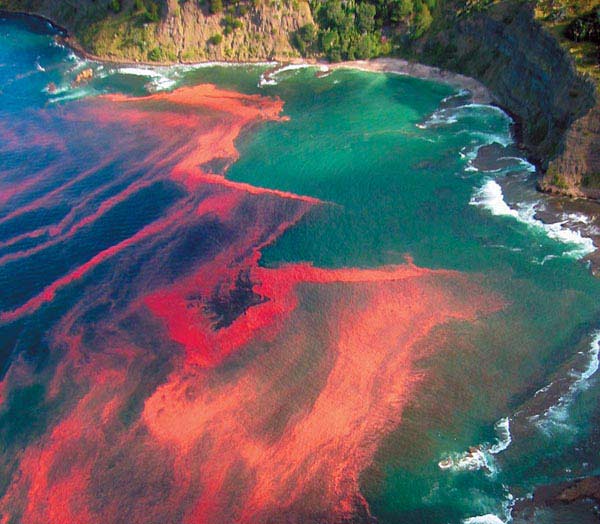In the last few months, scientists have observed a large increase in the number of aquatic mammals such as dolphins and whales washing up dead on coasts around the world. This trend is not limited to only dolphins and whales though. Fish have also been mysteriously dying off by the hundreds of thousands in places around the globe. Explanations for these mass deaths range from fertilizer poisoning all the way to radiation from Fukushima. One thing is clear though: If we continue to ignore the issues at hand, the problem can only get worse.

Algae carpets a beach near a Chinese City. Algal blooms such as these are becoming more and more common each year
Since the beginning of July of this year, all along the East Coast, hundreds of bottlenose dolphins have washed up on beaches stretching as far north as New York. The last time that something like this was seen was in the late 1980’s when over 700 bottlenose dolphins were found dead along the East Coast. The cause for these deaths was determined to be morbillivirus, a virus similar to the one that causes measles. In addition to this virus, scientists also found large amounts of brevetoxin, a toxic compound produced by algal blooms. In recent years, the number of these algal blooms has skyrocketed, and may be to blame for not only the bottlenose dolphin deaths, but also the death of fish around the globe. An algal bloom begins when seawater becomes saturated with nutrients such as potassium and nitrogen. These often end up in the ocean as a byproduct of agricultural run-off. The nutrients allow for an uncontrolled rapid growth of algae and cyanobacteria, which can sometimes be toxic to marine life in the surrounding area. At times, the algal blooms can become so large that they deprive the surrounding water of all nutrients and oxygen, essentially killing everything below them from suffocation or starvation. When these blooms are combined with ambient dangers such as pollution and infection, the results can be disastrous as seen in both the dolphin deaths during 1988 and of this past summer.
Compounding the issue of pollution and its negative effects on the ocean, poor fishing habits are wreaking havoc on the maritime environment. The consequences have been felt in many countries across the globe as fish stocks run low. According to experts in the UN Environment Programme, fish stocks may run dry in as soon as 40 years if we continue at our current pace (without further growth of the industry). Without these species of fish, not only will fisheries run dry, but foreign, invasive, and dangerous species of aquatic life will invade beaches. Even today, in places such as Spain, stinging jellyfish which are rarely ever seen so far north have begun to populate the waters off of beaches because they lack natural predators- fish. With fewer fish, the jellyfish are able to take advantage of the larger food supply and multiply exponentially.
The bottom line: If we continue at our current rate of overfishing and pollution of the ocean, not only will many maritime species be driven to extinction, but we will also have to deal with the repercussions of an ocean without these species.
How can you help? Check here to find out: http://overfishing.org/pages/what_can_I_do_to_help.php







Be the first to comment on "Our Oceans in Peril"